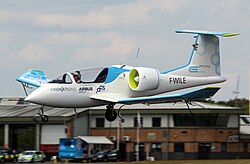Airbus E-Fan
| Airbus E-Fan | |
|---|---|
 E-Fan, Farnborough 2014 |
|
| Type: | Light aircraft , experimental aircraft |
| Design country: | |
| Manufacturer: | |
| First flight: |
March 11, 2014 |

The Airbus E-Fan is a two-seater electric aircraft from Airbus Group Innovations and was built by Aéro Composites Saintonge in Royan ( Charente-Maritime department , France). Although classified as a "Training Aircraft", the system should mainly be used to test new drive concepts. The further development of the machine was stopped in 2017.
history
The electric aircraft was designed and made ready for flight by a team of 5 to 18 people in an 18-month development period. It is the follow-up project to CriCri and was presented in 2013 at the Paris Air Show in Le Bourget. The first flight took place on March 11, 2014 at Bordeaux-Mérignac airport . A series production of the E-Fan 2.0 of around 100 units was planned. Production was to take place at the Pau-Pyrenees airport . The commissioning should take place at the end of 2017. A variant with four seats as an E-Fan 4.0 was already visualized.
In April 2017, Airbus announced that it no longer wanted to pursue the project.
The project was an essential part of the industrial plan for electric aircraft and new generation aircraft of the government initiative La Nouvelle France Industrielle , in which Airbus u. a. and Zodiac Aerospace and Siemens are involved.
construction
It is driven by two ducted propellers with variable pitch . The electric motors have a maximum total output of 60 kW. Lithium-ion batteries are housed in the wings for energy storage .
use
On July 10, 2015, the pilot Didier Esteyne crossed the English Channel from Dover to Calais with an e-fan . However, the flight did not bring the expected record - the day before, Air France pilot and stunt pilot Hugues Duval crossed the English Channel in a CriCri as the first electric aircraft to cross the English Channel in the opposite direction.
Technical specifications
| Parameter | Data |
|---|---|
| Type | Tandem two-seater with double controls |
| crew | 1 (pilot, see above) |
| Passengers | 1 (student pilot, see above) |
| Instruments | EFIS (Electr. Flight Instrument System) |
| length | 6.67 m |
| span | 9.50 m |
| Empty mass | 550 kg |
| Start speed | 110 km / h |
| Cruising speed | 160 km / h |
| Top speed | 220 km / h |
| Range | approx. 40 min flight time, planned> 1 h |
| battery | 250 V lithium-ion polymer |
| Electrical system | 24 V |
| Engines | two electric motors with 30 kW each (60 kW total output), 270 V intermediate circuit voltage |
| Thrust | 1.5 kN |
Web links
- Airbus Group E-Fan. The future of electric aircraft. In: Corporate Social Responsibility. Airbus Group, 2016, accessed May 24, 2019 .
- golem.de - Test flight of the Airbus E-Fan 2.0 on April 25, 2014 (video)
Individual evidence
- ↑ a b c d Electric Airplane: The Future of Aviation? ( Memento from September 7, 2014 in the Internet Archive ), Future magazine in Arte + 7, on September 6, 2014 at 1:30 p.m., approx. 30 min., Arte.tv (video).
- ↑ Take off without emissions: Airbus builds 100 electric planes www.spiegel.de, May 7, 2015
- ↑ The future of e-aircraft - Electricity is in the air, airbusgroup.com.
- ↑ a b E-Fan 4: vers un avion électrique pour le transport des passagers? (French), Interview by TourMaG magazine, August 19, 2014, tourmag.com.
- ↑ Andreas Wilkens: Electric Airplanes: Siemens sets speed records, Airbus stops development of the E-Fan on www.heise.de, April 6, 2017
- ↑ Robert Klages: E-planes cross the English Channel. Small electric aircraft is ahead of Airbus. Der Tagesspiegel , July 10, 2015, accessed on May 24, 2019 .
- ^ Volker K. Thomalla : Electric race over the canal. Airbus E-Fan versus Cri-Cri. In: Aerokurier edition 09/2015. Aerokurier , March 14, 2016, accessed April 27, 2016 .